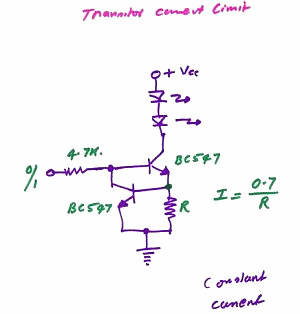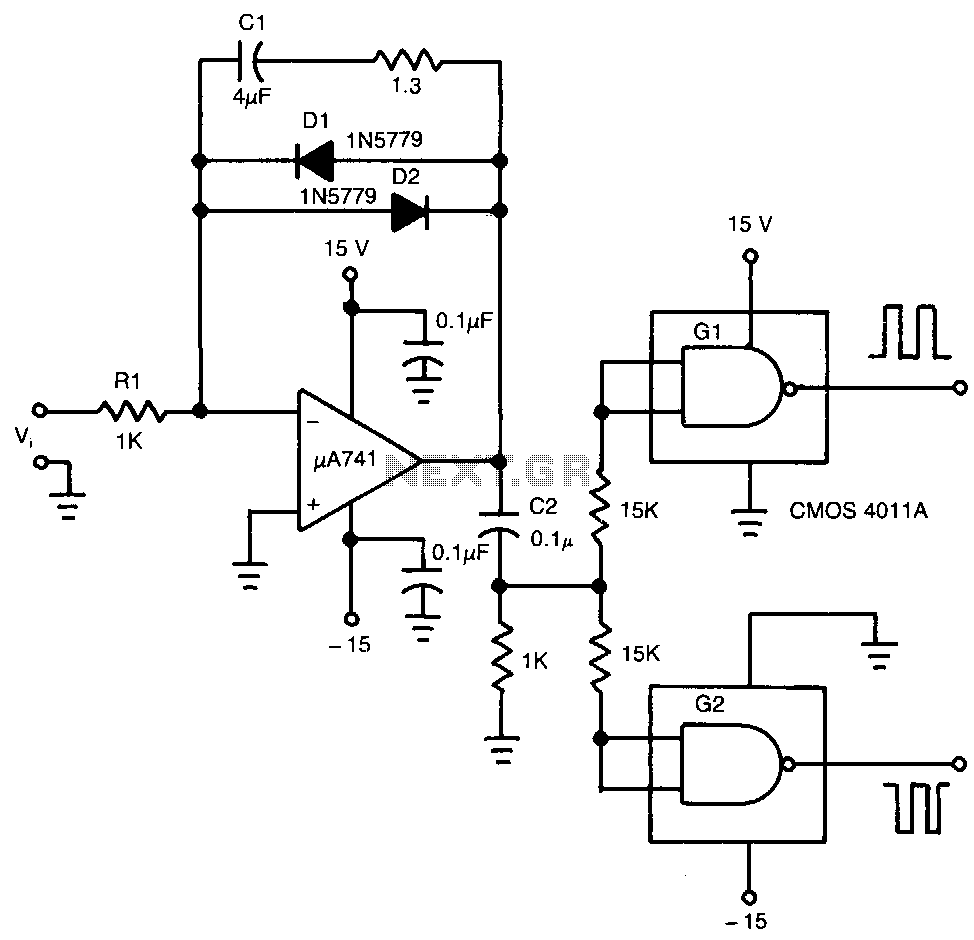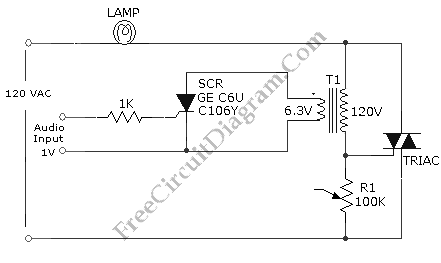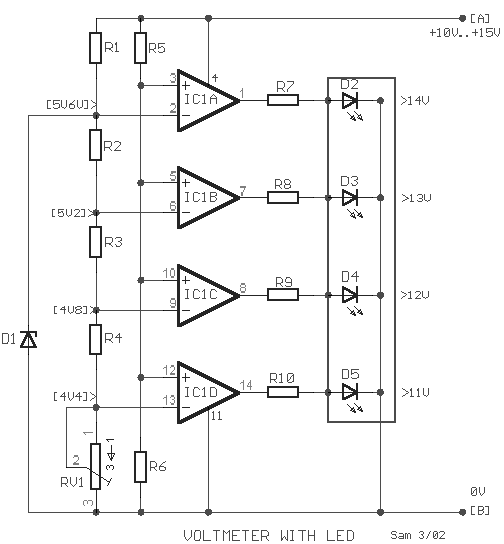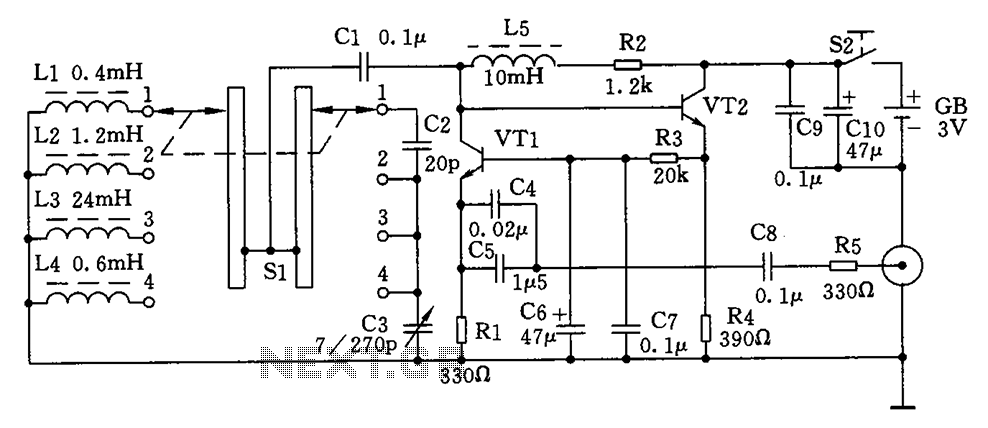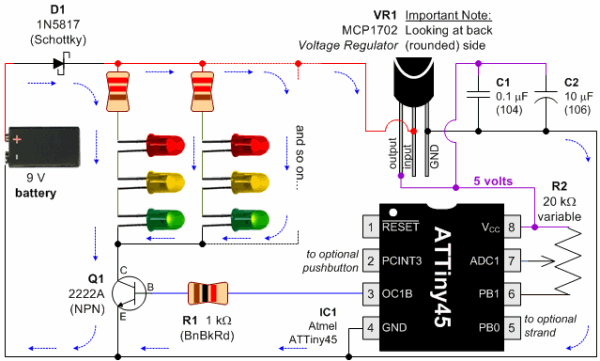
high voltage white led driver
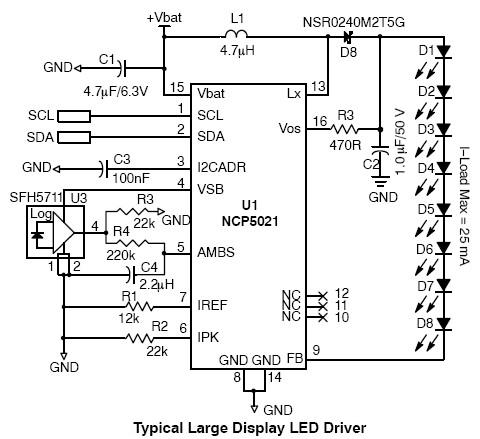
This high-voltage white LED driver electronic circuit schematic utilizes the NCP5021 integrated circuit from On Semiconductor. The NCP5021 is designed with an ambient light sensing feature and can drive up to eight LEDs in series for portable backlight applications. The built-in DC-DC converter employs a highly efficient PWM boost structure, achieving an output voltage of 32 V. The schematic is straightforward, requiring few external components, and can be interfaced with another device or microcontroller via I2C protocol. Key features of the NCP5021 high-voltage LED driver include a 2.7 to 5.5 V input voltage range, 90% peak efficiency with a 4.7 µH / 150 mΩ inductor, gradual dimming with an automatic fade-in/fade-out effect, integrated ambient light sensing for automatic adjustment of LCD backlight contrast, and full support for I2C protocol with address extension. The NCP5021 is specifically designed for backlight driver applications in devices such as cellular phones, smartphones, portable media players (PMPs), and global positioning systems (GPS).
The NCP5021 high-voltage white LED driver circuit is engineered for efficiency and versatility in portable electronic devices. The PWM boost converter architecture allows for a compact design while providing the necessary voltage to drive multiple LEDs in series. This is particularly advantageous in applications where space is limited, such as in smartphones and portable media players.
The ambient light sensing feature is a notable addition, enabling the circuit to automatically adjust the brightness of the backlight based on surrounding light conditions. This not only enhances user experience by ensuring optimal visibility but also contributes to energy savings by reducing power consumption in well-lit environments.
The input voltage range of 2.7 to 5.5 V allows the NCP5021 to operate from various power sources, making it suitable for battery-operated devices. The high efficiency of up to 90% ensures minimal heat generation, which is critical for maintaining device performance and longevity.
The gradual dimming capability, with its automatic fade-in and fade-out effects, provides a smoother transition in backlight brightness, enhancing the aesthetic appeal of the device. The integration of I2C protocol support allows for easy communication with microcontrollers, facilitating control over the LED driver and enabling advanced functionalities such as dynamic brightness adjustment and status monitoring.
Overall, the NCP5021 high-voltage white LED driver circuit is a robust solution for backlighting needs in modern electronic devices, combining efficiency, adaptability, and user-friendly features.This high voltage white LED driver electronic circuit schematic is based on the NCP5021 IC manufactured by On Semiconductor. This NCP5021 high voltage white LED driver electronic circuit is designed with ambient light sensing feature.
The NCP5021 white LED driver is capable of driving up to 8 LEDs in series for portable backlight applications. T he built ’in DC DC converter is based on a high efficient PWM boost structure with 32 V output voltage span. The schematic circuit is very simple, requiring few external electronic parts and it can be connected through an I2C protocol to another device or microcontroller.
Main features of the NCP5021 high voltage LED driver are : 2. 7 to 5. 5 V Input Voltage Range, 90% Peak efficiency with 4. 7 _H / 150 m_ Inductor, Gradual Dimming Built ’in (Automatic Fade In/Fade Out Effect), Integrated Ambient Light Sensing Automatically Adjusts the LCD, Backlight Contrast, Support the Full I2C Protocol with Address Extension. NCP5021 is a high voltage LED driver is specially designed for backlight driver in applications like : Cellular Phone, Smartphone, Portable Media Player (PMP), Global Positioning System (GPS).
🔗 External reference
The NCP5021 high-voltage white LED driver circuit is engineered for efficiency and versatility in portable electronic devices. The PWM boost converter architecture allows for a compact design while providing the necessary voltage to drive multiple LEDs in series. This is particularly advantageous in applications where space is limited, such as in smartphones and portable media players.
The ambient light sensing feature is a notable addition, enabling the circuit to automatically adjust the brightness of the backlight based on surrounding light conditions. This not only enhances user experience by ensuring optimal visibility but also contributes to energy savings by reducing power consumption in well-lit environments.
The input voltage range of 2.7 to 5.5 V allows the NCP5021 to operate from various power sources, making it suitable for battery-operated devices. The high efficiency of up to 90% ensures minimal heat generation, which is critical for maintaining device performance and longevity.
The gradual dimming capability, with its automatic fade-in and fade-out effects, provides a smoother transition in backlight brightness, enhancing the aesthetic appeal of the device. The integration of I2C protocol support allows for easy communication with microcontrollers, facilitating control over the LED driver and enabling advanced functionalities such as dynamic brightness adjustment and status monitoring.
Overall, the NCP5021 high-voltage white LED driver circuit is a robust solution for backlighting needs in modern electronic devices, combining efficiency, adaptability, and user-friendly features.This high voltage white LED driver electronic circuit schematic is based on the NCP5021 IC manufactured by On Semiconductor. This NCP5021 high voltage white LED driver electronic circuit is designed with ambient light sensing feature.
The NCP5021 white LED driver is capable of driving up to 8 LEDs in series for portable backlight applications. T he built ’in DC DC converter is based on a high efficient PWM boost structure with 32 V output voltage span. The schematic circuit is very simple, requiring few external electronic parts and it can be connected through an I2C protocol to another device or microcontroller.
Main features of the NCP5021 high voltage LED driver are : 2. 7 to 5. 5 V Input Voltage Range, 90% Peak efficiency with 4. 7 _H / 150 m_ Inductor, Gradual Dimming Built ’in (Automatic Fade In/Fade Out Effect), Integrated Ambient Light Sensing Automatically Adjusts the LCD, Backlight Contrast, Support the Full I2C Protocol with Address Extension. NCP5021 is a high voltage LED driver is specially designed for backlight driver in applications like : Cellular Phone, Smartphone, Portable Media Player (PMP), Global Positioning System (GPS).
🔗 External reference
